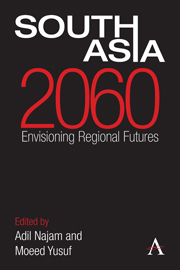Book contents
- Frontmatter
- Contents
- Acknowledgments
- List of Abbreviations
- Introduction: Imagining South Asian Futures
- Section I South Asia as a Region
- Section II State Relations
- Section III Development
- Chapter 16 South Asian Economy in 2060
- Chapter 17 Economic Futures: Challenges Ahead
- Chapter 18 South Asia in the Asian Economy: Struggling to Overcome History
- Chapter 19 Globalization and South Asia
- Chapter 20 Trade Relations: Some Predictions and Lessons
- Chapter 21 Urban Policy for Environmental Quality and Well-Being
- Chapter 22 Urban Futures, Urban Challenges
- Chapter 23 Water Security: Risks and Responses
- Chapter 24 Agriculture and Food Security
- Chapter 25 Meeting Electric Power Demand in South Asia
- Chapter 26 E-South Asia: A Social Science Fiction
- Section IV Human Well-Being
- About the Authors
- Bibliography
- Index
Chapter 20 - Trade Relations: Some Predictions and Lessons
from Section III - Development
Published online by Cambridge University Press: 05 September 2013
- Frontmatter
- Contents
- Acknowledgments
- List of Abbreviations
- Introduction: Imagining South Asian Futures
- Section I South Asia as a Region
- Section II State Relations
- Section III Development
- Chapter 16 South Asian Economy in 2060
- Chapter 17 Economic Futures: Challenges Ahead
- Chapter 18 South Asia in the Asian Economy: Struggling to Overcome History
- Chapter 19 Globalization and South Asia
- Chapter 20 Trade Relations: Some Predictions and Lessons
- Chapter 21 Urban Policy for Environmental Quality and Well-Being
- Chapter 22 Urban Futures, Urban Challenges
- Chapter 23 Water Security: Risks and Responses
- Chapter 24 Agriculture and Food Security
- Chapter 25 Meeting Electric Power Demand in South Asia
- Chapter 26 E-South Asia: A Social Science Fiction
- Section IV Human Well-Being
- About the Authors
- Bibliography
- Index
Summary
While home to about 20 percent of the world's population and 40 percent of the world's poor, South Asia accounts for only about 3 percent of both global gross domestic product (GDP) and total world trade. The states of the region have followed a long history of protectionism with inward looking polices that curtailed the region's economic growth as well as its trade flows, both within and outside the region. Unilateral liberalization initiatives started in the 1990s and worked towards accelerating growth – raising trade and investment flows in the region and as a result South Asia's growth rate over the last decade has exceeded the average in developing countries. Likewise, the region's export and import growth has been quite robust at 9.1 and 4.1 percent respectively in 2012 against 7.0 and 6.2 percent in developing countries (UNCTAD 2012).
At the outset, references to regional trade in South Asia need to account for the diversity and varied priorities of the different member states of the South Asian Association for Regional Cooperation (SAARC): India is a major emerging economy with substantial economic and political clout not only in South Asia but also in the world; Pakistan, Sri Lanka, Bhutan and Maldives are developing nations, while Afghanistan, Bangladesh and Nepal are least developed member states. Additionally, while Sri Lanka and the Maldives are small island states, Afghanistan, Bhutan and Nepal are landlocked nations.
- Type
- Chapter
- Information
- South Asia 2060Envisioning Regional Futures, pp. 153 - 159Publisher: Anthem PressPrint publication year: 2013



